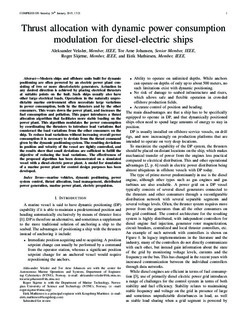Thrust Allocation with Dynamic Power Consumption Modulation for Diesel-Electric Ships
Journal article, Peer reviewed
Accepted version

Åpne
Permanent lenke
http://hdl.handle.net/11250/2469891Utgivelsesdato
2016Metadata
Vis full innførselSamlinger
- Institutt for marin teknikk [3432]
- Publikasjoner fra CRIStin - NTNU [38127]
Originalversjon
IEEE Transactions on Control Systems Technology. 2016, 24 (2), 578-593. 10.1109/TCST.2015.2446940Sammendrag
Modern ships and offshore units built for dynamic positioning (DP) are often powered by an electric power plant consisting of two or more diesel-electric generators. Actuation in any desired direction is achieved by placing electrical thrusters at suitable points on the hull. Usually, such ships also have other large electrical loads. Operations in the naturally unpredictable marine environment often necessitate large variations in power consumption, both by the thrusters and by the other consumers. This wears down the power plant and increases the fuel consumption and pollution. This paper introduces a thrust allocation algorithm that facilitates more stable loading on the power plant. This algorithm modulates the power consumption by coordinating the thrusters to introduce load variations that counteract the load variations from the other consumers on the ship. To reduce load variations without increasing the overall power consumption, it is necessary to deviate from the thrust command given by the DP system. The resulting deviations in the position and velocity of the vessel are tightly controlled, and the results show that small deviations are sufficient to fulfill the objective of reducing the load variations. The effectiveness of the proposed algorithm has been demonstrated on a simulated vessel with a diesel-electric power plant. A model for the simulation of a marine power plant for control design purposes has been developed.